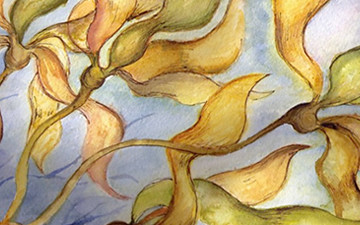Nereocystis (Greek for “mermaid’s bladder”) is a genus of kelp. It forms thick beds on rocks, and is an important part of kelp forests. There is only one species, Nereocystis luetkeana. It can grow to a maximum of 74 meters. Nereocystis has aholdfast of about 40 centimeters, and a single stipe, topped with a pneumatocyst containing carbon monoxide, from which sprout the numerous (about 30-64) blades. The blades may be up to 4 meters long, and up to 15 centimeters wide. It is usually annual, sometimes persisting up to 18 months. Nereocystis is the only kelp which will drop spore patches, so that the right concentration of spores lands near the parent’s holdfast. It is common along the coast of the northeastern Pacific Ocean, from about Monterey, California to Aleutian Islands, Alaska.
Some common names include edible kelp, bull kelp, bullwhip kelp, ribbon kelp, giant kelp, bladder wrack, and variations on these names.[1]
(From Wikipedia.org, July 15 2010)
– – –
“Kelp’s survival depends on flexibility and extensibility. Each alga can grow up to 20 to 45 m (22 to 49 yd) long and consists of a holdfast, stipe, float, and fronds. The holdfast uses a flexible network of root-like haptera or anchors to attach the kelp to the ocean floor. By being flexible, the haptera allow the kelp’s base to rotate slightly, thus providing some protection from the high torque created by waves.” (Biomimicry Guild unpublished report)
(From AskNature via The Encyclopedia of Life, July 15 2010)
– – –




